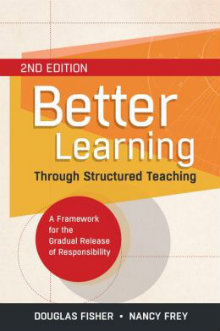An Essential Guide to Gradual Release of Responsibility
Better Learning Through Structured Teaching: A Framework for the Gradual Release of Responsibility, 2nd Edition
By Douglas Fisher and Nancy Frey
(ASCD, 2013 – Learn more)

I felt as if I couldn’t write this review fast enough because every teacher should read this book before returning to school this fall.
Through specific classroom examples and deep knowledge in the field, Douglas Fisher and Nancy Frey inspire us to lead our students to become independent learners.

For new and veteran teachers alike, Better Learning Through Structured Teaching may be best digested in bits, one chapter or section at a time. You could also start with the introduction and then skip over to the extensive lesson plan in the last chapter – to see how all the concepts play out in real life – before returning to the copious helpful examples of the previous four chapters.
“Gradual release of responsibility,” the book’s central idea, means that responsibility for learning slowly moves from the teacher to the student through a series of steps:
1) Focused instruction (“I do it”)
2) Guided instruction (“We do it”)
3) Collaborative learning (“You do it together”)
4) Independent learning (“You do it alone”).
Of course, the process is not always linear and can be highly recursive.
I first encountered the idea of gradual release of responsibility through my mom, an English teacher who, during my first year of teaching, blessedly vetted each day’s lesson plans by phone the night before. She designed her writing curriculum around the four steps above. It sounded like folk wisdom then, but I later learned that she was standing on the shoulders of giants, as this book acknowledges.
At the outset the authors refer to Piaget’s “work on cognitive structures and schemata,” Vygotsky’s “work on zones of proximal development,” Bandura’s “work on attention, retention, reproduction, and motivation,” and Wood, Bruner and Ross’s “work on scaffolded instruction.”
This second edition of Fisher and Frey’s book feels current. It refers to the Common Core’s intent to “move from teaching facts to teaching thinking,” and it brings in relevant technology frequently through, for instance, a thoughtful discussion of blended learning with classroom examples.
Step 1: “Focused Instruction: Purpose, Modeling, Think-Alouds, and Noticing”
This chapter emphasizes the importance of the focused instruction phase, when we show students how to do a skill or task.
It exhorts, “Telling students what they will be doing but not why and how and when and when not presumes a tremendous amount of motivation and skill. Some students may learn well enough without whys, hows, whens, and when nots, but many more will not.” Helping students see such metacognition, ours and their own, is a thread that runs through the entire book.
This chapter also reminds us to “think aloud” in a way that not only shows our expert perspective but keeps in mind the view of a novice.
My favorite idea in this chapter is that of noticing student understandings and misconceptions so as to effectively teach smaller groups later on.
Step 2: “Guided Instruction: Questions, Prompts, and Cues”
Guided instruction can take many forms. While “the teacher focuses on scaffolding students’ developing skill or knowledge through questioning, prompting, and cuing” – usually in flexible groups depending on who needs what on that day – the rest of the students are on their own doing collaborative or independent learning.
This chapter presents so many different methods of guided instruction, from close reading to analyzing misconceptions, that you could try a number of different approaches over the course of a unit to see which ones work best for your students and the material.
Step 3: “Collaborative Learning: Consolidating Thinking With Peers”
The chapter begins with an excellent case for collaborative learning, mentioning the Common Core, 21st century skills, and “soft” attributes that employers seek.
It then gives a phenomenal summary of all kinds of group learning, from labs and simulations to Jim Burke’s conversational roundtable graphic organizer.
Fisher and Frey distinguish between basic group work, which “primarily draws on existing knowledge,” and productive group work, in which “solving problems and identifying solutions are central thinking goals.” They also discuss ways to embed individual accountability in collaborative group work, a perennial issue.
Little in this chapter seemed entirely new, but it made the possibilities for productive collaborative learning seem endless.
Step 4: “Independent Learning: Applying What Has Been Taught”
This may have been my favorite chapter, and I didn’t expect it because the topic is the least flashy of the four methods of instruction: doing independent work, or “working and thinking alone.”
What made this chapter resonate is that it reminds us, over and over, to make the independent work we assign meaningful, whether it is done in class or for homework.
We can create such meaning by encouraging students to engage in metacognition and self-regulation, and we can foster their understanding by giving specific and clear feedback that helps them become even more self-directed.
There’s an excellent chart on “Developing Effective Homework Assignments,” sorted by the purpose of homework, that would make any teacher think twice about piling on problems or worksheets without giving a good reason why.
Summing Up
The last chapter offers a synthesis of how Fisher and Frey’s body of work connects with that of other big hitters in the field: with “Tomlinson and Imbeau’s (2010) differentiation of instruction, Wiggins and McTighe’s (2005) Understanding by Design (UbD®) process, and Popham’s (2008) take on formative and transformative assessment.”
This chapter is well worth reading for its theoretical background and also for its real-world unit plan on immigration for a middle school studies class.
Ultimately, Fisher and Frey end their book with an appeal to us as teachers to “reconsider how you learn. Think about the things you are good at and about how you got good.”
By thrusting us back into how we learned our own passions, they help us remember how nonlinear and messy the process may have been – and how grateful we were to the people who made the steps clear for us.
Sarah Cooper teaches eighth-grade U.S. history and is co-dean of faculty at Flintridge Preparatory School in La Canada, California. She lives just outside Los Angeles with her husband and two sons, both in elementary school. She is the author of Making History Mine (Stenhouse, 2009) and writes and reviews books for MiddleWeb.




































